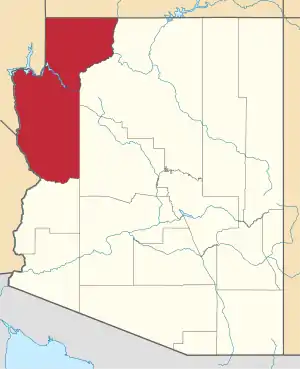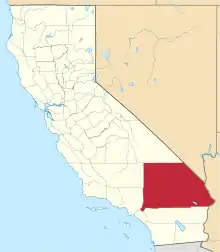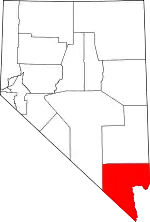Fort Mojave Indian Reservation
The Fort Mohave Indian Reservation is an Indian reservation along the Colorado River, currently encompassing 23,669 acres (95.79 km2) in Arizona, 12,633 acres (51.12 km2) in California, and 5,582 acres (22.59 km2) in Nevada. The reservation is home to approximately 1,100 members of the federally recognized Fort Mojave Indian Tribe of Arizona, California, and Nevada, a federally recognized tribe of Mohave people.
Fort Mojave Indian Reservation | |
|---|---|
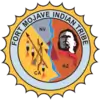 Seal | |
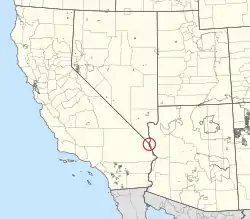 Location in Arizona, California, and Nevada | |
| Tribe | Fort Mojave |
| Country | United States |
| States | Arizona California Nevada |
| Counties | Clark Mohave San Bernardino |
| Established | 1870 |
| Headquarters | Needles |
| Government | |
| • Body | Fort Mojave Tribal Council |
| • Chairman | Tim Williams |
| • Vice-Chairman | Shan Lewis |
| Area | |
| • Total | 65.44 sq mi (169.5 km2) |
| Population (2017)[2] | |
| • Total | 1,707 |
| • Density | 26/sq mi (10/km2) |
| Website | fortmojaveindiantribe.com |
Native Americans occupy less than 50 percent of the Mojave reservation. The Mohave people have leased much of their land to cotton, corn, and soybean farming companies, which employ a large population of resident European-Americans and Mexican Americans.[3]
The site of the former Fort Mohave and the eastern terminus of the Mojave Road are situated within the Fort Mojave Indian Reservation.
History
These lands were occupied for thousands of years by succeeding cultures of Indigenous peoples. The property covers areas along the Colorado River of the three adjacent states of Arizona, California, and Nevada. It also is sporadically traversed by the Mojave River in California.
The Fort Mohave Indian Reservation was established in 1890, and comprised the land of the former camp Mojave military reservation, thereby transferring it from the War Department to the Office of Indian Affairs. [4] For decades until the early 1930s, it operated an Indian boarding school for Native American students from the Mohave and other tribes, as part of efforts to assimilate youth to the mainstream culture. They were forced to speak English and practice Christianity while at the school. The property was transferred to the reservation in 1935. It has allowed the buildings to deteriorate, as they were symbolic of a painful period in relations with the US.
Economy
The Mojave have leased considerable amounts of reservation land to agricultural companies for cultivation of commodity crops: soybeans, corn, and alfalfa. Many White and Mexican American workers live here, and less than 50% of the reservation is occupied by Mohave and other Native Americans.
From 1995 the tribe operates the Avi Resort & Casino in Nevada.[5] On October 20, 2003, the reservation government announced an agreement between the reservation and California Governor Gray Davis to allow the operation of a casino west of Needles, California (directly across the Colorado River from the Tribe's Arizona Reservation Lands).
Language revitalization
As of 2012, The Center for Indian Education at Arizona State University "has facilitated "workshops for both learners and speakers at the Fort Mojave Indian Reservation in northwest Arizona, California and Nevada. Fort Mojave has about 22 elders who speak some Mojave."[6] The project is also bringing elders together with younger people to teach the traditional Mojave "bird songs."[7]
The language preservation work of poet Natalie Diaz on the reservation was featured on the PBS News Hour in March 2012.[8]
Location
The Fort Mojave Indian Reservation is located at 34°56′34″N 114°36′33″W.[9]
Communities
- Arizona Village, Arizona (part)
- Fort Mohave, Arizona (part)
- Golden Shores, Arizona (part)
- Mesquite Creek, Arizona
- Mohave Valley, Arizona (part, population 121)
- Mojave Ranch Estates, Arizona
- Needles, California (part, population 208)
- Willow Valley, Arizona (part)
References
- "Tribal Council". Retrieved 2019-07-24.
- 2013-2017 American Community Survey 5-Year Estimates. "My Tribal Area". United States Census Bureau.
- Fort Mojave Reservation and Off-Reservation Trust Land, Arizona/California/Nevada United States Census Bureau
- Avi Resort & Casino
- Mary Shinn (2010-11-29). "ASU center bringing new life to Native languages". The State Press. Retrieved 2012-09-11.
- Pete Zrioka (2012-03-26). "Cultural conservation: keeping languages alive". Arizona State University News. Retrieved 2012-09-11.
- Mary Jo Brooks (2012-06-20). "On Wednesday's NewsHour: Poet Natalie Diaz". Art Beat PBS NewsHour. Retrieved 2012-09-11.
- U.S. Geological Survey Geographic Names Information System: Fort Mojave Reservation
External links
- Official Tribe Website
- Fort Mojave Reservation, Northern Arizona University
- Fort Mojave Tribe, InterTribal Council of Arizona
